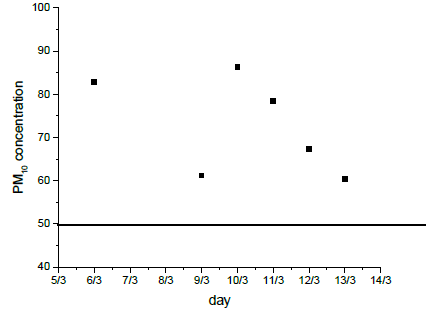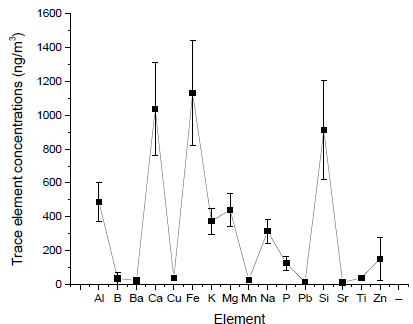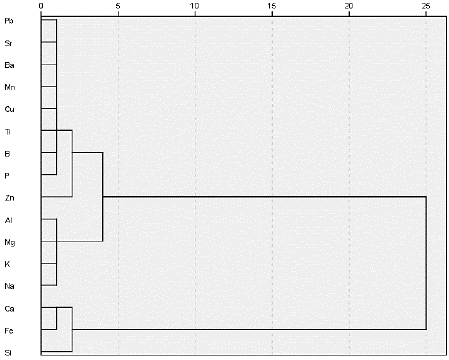1. Introduction
The city of Lima has aerosol problems that mainly come from vehicular, industrial, and natural sources [1,2]. In 2021, Lima had a population of 10,882,757 and in 2019, the motor vehicle population consisted of 1,982,650 vehicles. The types of vehicles that are driven in Lima are buses, automobiles, trailers, rural cars, pickups, semi-trailers, and removers [3]. In Lima, a momentary exposure to fine particles concentrations is related to the rise in emergency room visits for stroke and respiratory diseases [4]. Organic carbon and elemental carbon were identified in downtown Lima [1]. The authors of [5] measured water-soluble carbon-organic in downtown Lima. Even though there are very few studies regarding the PM10 chemical in Lima [1,5], this is the first study to analyze trace metals according to the backward trajectory of PM10 concentrations and cluster analysis in southern Lima. The backward-trajectories analysis was used to discover the source of pollutions such as aerosol [6]. Many studies in the world used the trajectories analysis. In China, the authors of [7] showed aerosol transport from southern China to Beijing. The authors of [8] pointed out the ozone transport to China. The authors of [9] reported the transport of volatile organic compounds from northern China to rural areas of central China. Yet, no air pollution research has used the Lagrangian trajectory analysis in southern Lima. Aerosol pollutions due to PM10 concentrations are an important problem for "public health" [10]. Aerosol-PM10 concentration consists of liquid or solid particles "suspended" in the atmosphere [10]. In this research, the air-mass-backward estimation trajectories of PM10 concentrations and its metals were performed in order to examine the transport path of aerosols-PM10 concentrations and its trace metals.
For this research, PM10 measurements were performed only in the period from March 06th to 14th, 2020, at the Universidad Nacional Tecnológica de Lima Sur, located in southern Lima. The measurements were scheduled to be performed during one month. They were supposed to be performed until approximately April 6th, 2020. However, the sampling of the PM10 measurements was interrupted from March 16, 2020 until this day due to COVID-19 in Peru and in the world. Due to this emergency, professors and students were not able to go to the university until January 24th, 2022. Therefore, the sampling that had to be carried out from March 14th to March 15th, 2020 was not considered. On June 25th, 2021, 191,447 people had died due to COVID-19 in Peru according to the report of the Peruvian Ministry of Health (on June 25th, 2021). Consequently, Peru ranks fifth in the world for COVID-19 deaths per 100,000 inhabitants. In Lima, the authors of [11] have shown that high numbers of COVID-19 infections and deaths were associated with people who had been exposed to aerosols for several years (2012 to 2016) before the onset of the pandemic as people have been sensitive to COVID-19 due to their exposure to aerosols in previous years of the COVID-19 pandemic. The goals of this investigation are: (1) to analyze PM10 and the trace elements concentrations in southern Lima from March 06 to 13, 2020; (2) to analyze the backward trajectory for extreme values of trace elements and PM10 concentrations; and, (3) to examine the cluster analysis for PM10 concentrations.
2. Material and methods
2.1 Sampling site, instrument, and trace elements analysis
The sampling location for PM10 measuring was on the rooftops (approximately 14-21 m above ground) of a building of the Universidad Nacional Tecnológica de Lima Sur (UNTELS), very near a street with little traffic. UNTELS is located approximately 2 kilometers away from the industrial area in the district of Villa El Salvador in southern Lima. Aerosol-PM10 samples were collected from March 06th to 13th, 2020 every 24 hours. The sampling began and ended at 10:00 local time. The geographical location of the sampling site (UNTELS) is shown in Fig. 1. The High-Volume Air Sampler (Tisch Environmental, Inc; USA) was used to obtain aerosol-PM10 samples with an 8"x10" quartz filter. The sampling place was chosen to cover the whole area of southern Lima.
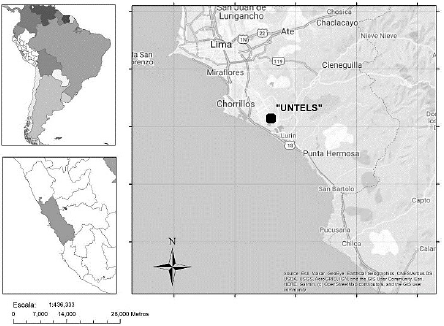
Source: The authors.
Figure 1 Map of the sampling site at UNTELS. UNTELS stands for Universidad Nacional Tecnológica de Lima Sur (National Technological University of Southern Lima).
The PM10 chemical analysis was performed by the "Inductively Coupled Plasma Atomic Emission Spectroscope" (ICP-AES) [12,13] in order to find the trace elements. The ICP-AES is additionally called "ICP-optical emission spectroscopy" that is a practical multielement analysis approach which simultaneously permits multi-metals quantification, and it is sensitive to trace metals content in the sampling [13,14]. Trace metals in Lima were quantified using the EPA's method which is EPA/625/R-96/010a that applies the ICP-AES procedure to discover trace elements. Other researchers also found inorganic metals. In research, in Italy, Si, Ca, S, Mg, Mn, K, Zn, Ni and Al was found [14]. Also, in another research in Italy the following metals were found: Pb, Zn, K, Ti, Cr, Ba, Cu, Ca, Mg, and Fe utilizing the ICP-AES method [13]. In a research paper in the Antarctica area Al, Ca, S and Ti were observed in a sample of PM10 [15]. In research in Mexico, Cd, Fe, As, Cu, Zn, and Ni were discovered in a PM2.5 sample employing ICP-AES [16]. More detailed information about the ICP-AES technique is found in [13,16].
2.2 Quantify 24-h-backward trajectory
To locate the probable origin of the remote source of trace elements and PM10 mass concentration two techniques were implemented: the PM10 arrival trajectory and the cluster analysis. To indicate the origin of air masses reaching UNTELS, 24-hour-air-mass-backward trajectories were computed using the NOAA HYSPLIT ("Single Particle Hybrid Lagrangian Integrated Trajectory") model from measurement place in order to confirm long-distance transport of trace metals and PM10 concentrations. This model can be found at the following website https://www.ready.noaa.gov/hypubbin/trajtype.pl?runtype=archive [17]. Meteorological data was supplied by the NCEP operational "Global Forecast System analysis" with 0.25-degree x 0,25-degree horizontal resolution (GFS). The air masses initiated at an altitude of 1 km just as [6].
3. Results and discussion
Fig. 2 shows that the daily PM10 concentrations from March 06th to 13th, 2020. PM10 varies from 60.4 µg/m3 to 86.3 µg/m3. The high values of PM10 concentrations were observed on March 06 and March 10, 2000. This happened when air masses came from the NW (24 hours before) and reached UNTELS from the north (Fig. 3) transporting the PM10 concentrations towards UNTELS. A high value of PM10 was observed on March 06, 2020. Low values of PM10 concentrations were observed when the air masses came from the SE. These air masses traveled towards UNTELS and arrived at UNTELS from the SE (Fig. 4). Mean daily PM10 concentrations throughout the study period exceeded the average daily value of 50 µg/m3 recommended by the WHO (Fig. 4). The daily ratio between the values of daily PM10 concentrations between the reference value of 50 µg/m3 in the research period varies from 1.2 to 1.7. The low ratio value of 1.2 occurs when air masses originate from the NW of Lima and arrive from the NW to the PM10 measurement site; while, the high ratio value of 1.7 occurs when air masses originate SSE of Lima and arrive from the SE at the PM10 sampling site.
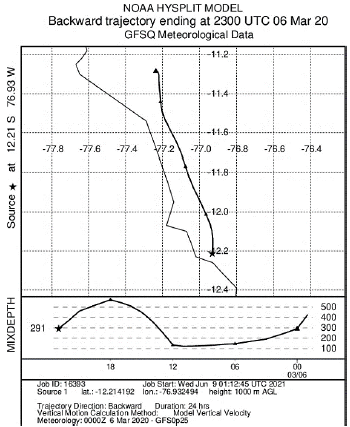
Source: The authors
Figure 3 The 24-hour air-parcel-backward evaluation trajectory of PM10 particles on March 06, 2020 at 2300 UTC.
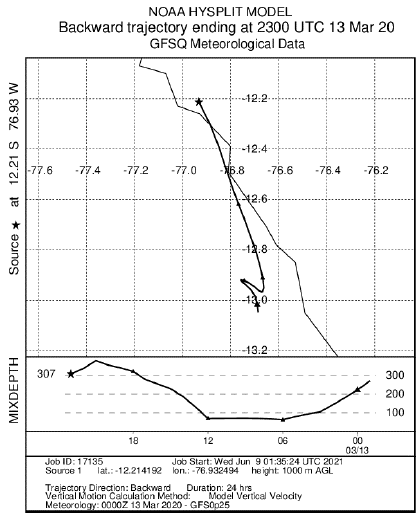
Source: The authors
Figure 4 The 24-h Lagrangian air-mass-backward trajectory of PM10 particles on March 13, 2020 at 2300 UTC.
The 24-h-backward trajectory of PM10 was implemented on March 06, 2020 at 23 UTC (Fig. 3). The air mass originated in Northern Huaral (a town north of Lima) in a typical desert area. Afterwards, an air mass passed through Huaral and the desert area. It passed through the urban area of Lima, i.e., the northern part of Lima and downtown Lima. Finally, the air mass reached the sampling site in southern Lima from the north. The air mass was located 12 hours away before reaching the sampling site with a mixing layer height (MLH) of approximately 110 meters. The MLH was 291 m when the air mass arrived at the sampling site (Fig. 3). Therefore, we can state that when the air mass originates in the desert area located to the NW of Lima, then the air mass passes through northern Lima (it is the most polluted area of Lima in Lima), afterwards the air mass passes through downtown Lima and then reaches southern Lima (where PM10 is measured). This may indicate the transport of PM10 and its metals from northern Lima to southern Lima. In a study in Sao Paulo city, Brazil, high PM10 concentrations came from the NE, and it was pointed out that some transport of PM10 concentrations can occur coming from the NE of the state of Sao Paulo to the city of Sao Paulo [18]. Also, the PM10-backward-trajectory for the case of low pollutant concentration (occurred on March 13th, 2020) was performed (Fig. 4). An air mass originated over the Pacific Ocean located at (13°03'0,2''S, 76°41'07''W) which is located to the west of the Cerro Azul district of the Caflete province in the south of the department of Lima. Afterwards, the air mass traveled over the Pacific Ocean, west of the district of Asia. The air mass remained over the Pacific Ocean and traveled west towards Chilca, Pucusana, Punta Negra, Punta Hermosa, and reached the coast of Lurín. This air mass stayed for approximately 23 hours and 30 minutes. Then it passed through Sector 4, the urban area of the Villa El Salvador district, to reach the PM10 sampling area from the SE (Fig. 4). So, we can state that when an air mass comes from the SSE from the Pacific Ocean, this SSE air mass is loaded with high humidity, which could generate low concentrations of PM10 particles and inorganic elements. Additionally, on March 13th, 2020, the MHL was 307 m.
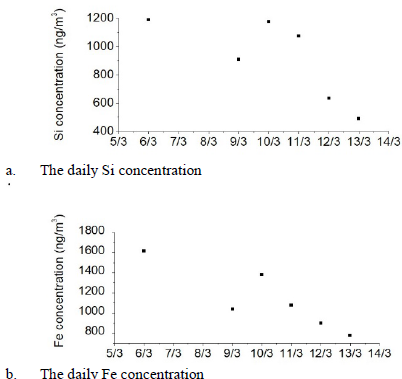
Source: The authors
Figure 5 The daily trace elements concentrations (ng/m3) from March 06 to 13, 2020. Figure 5a for Si; Figure 5b for Fe
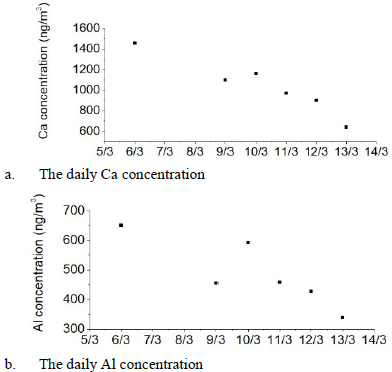
Source: The authors
Figure 6 The daily trace elements concentrations (ng/m3) from March 06 to 13, 2020. Figure 6a for Ca; Figure 6b for Al.
Fig.5-6 show the variation of daily Si, Fe, Ca, and Al from March 06th to March 13th, 2020. The highest values of Si, Fe, Ca, and Al were observed on March 06th, 2020. This could be due to the backward NW trajectory (Fig. 3) that allowed the air mass to transport those trace metals from the desert area (located NW of Lima) to the sampling site. Whereas the lowest trace metals concentrations values of Si, Fe, Ca, and Al were observed on 13 Marchth 2020 that could be due to the fact that the air mass originated over the Pacific Ocean, SSE of UNTELS. Moreover, the air mass was coming with a high relative humidity and low values of trace elements from the Pacific Ocean (SSE of Lima) to the sampling place (Fig.4). The air mass transported the high relative humidity toward UNTELS on March 13th, 2020 (Fig. 4). Si concentration varied from 492.3 ng/m3 to 1191.2 ng/m3 (Fig.5); Fe concentration varied from 778.3 ng/m3 to 1614.9 ng/m3 (Fig. 5); Ca concentration varied from 638.9 ng/m3 to 1456.1 ng/m3 (Fig.6); Al concentration varied from 339.4 ng/m3 to 650.9 ng/m3 (Fig. 6) at UNTELS in the research period. Ratio Ca/Al, Fe/Al, and Si/Al are 2.1, 2.,3 and 1.9, respectively. Those could be due to the fact that Ca, Fe, and Si were transported from the desert area to the sampling site at UNTELS.
Fig. 7 shows the mean of trace elements concentrations from March 06th to March 13th,2020 sampled at UNTELS.
The average and deviations standard are for Al (487.5 ± 114.3 ng/m3); for B (39.9 ± 35.2 ng/m3); for Ba (23.5 ± 5.5 ng/m3); for Ca (1037.7 ± 274.3 ng/m3); for Cu (36.9 ± 10.2 ng/m3); Fe (1132.3 ± 312.1 ng/m3); for K (374.3 ± 77.7 ng/m3); for Mg (439.9 ± 97.6 ng/m3); for Mn (26.3 ± 8.5 ng/m3); for Na (314.0 ± 70.4 ng/m3); for P (125.1 ± 41.1 ng/m3); Pb (12.4 ± 2.2 ng/m3); for Si (913.2 ± 292.9 ng/m3); for Sr (10.8 ± 3.2 ng/m3); for Ti (39.0 ± 8.5 ng/m3); for Zn (150.9 ± 126.6 ng/m3); respectively. The following trace elements Ag, As, Cd, Co, Cr, Ni, Se, Sn, Ce, Sb, and Be were below the detection limit of the equipment. The high values of trace metals, such as Al, Ca, Fe, Mg, and Si (Fig. 7) were elements from metals generated from source soil. In a Sao Paulo city, Brazil research, the authors of [19] associated calcium concentration with suspended soil dust. Cu concentrations coming from vehicular emissions were observed at UNTELS. Moreover, in a Sao Paulo city, Brazil research article, the authors of [19] associated Cu concentration with vehicle emissions. The average of Zn (150.9 ± 126.6 ng/m3) and Cu (36.9 ± 10.2 ng/m3) are associated with traffic flow such as [20]. The trace metals can be ranked according to amounts: Fe > Ca > Si > Al > Mg > K > Na > Zn > P > B > Ti > Cu > Mn > Ba > Pb > Sr. The values of iron (Fe) were the most abundant trace metals in Lima. Sources could be soil and vehicular emissions. In addition, in research in Sao Paulo city, Brazil, Fe concentrations were higher due to powerful contributions from vehicular and dust sources [1]. However, in this research, in Lima, very small trace metals of B, Ti, Cu, Mn, Ba, Pb, and Sr were observed. These metals contributed very little to the total PM10 mass concentration. To decide if trace elements originated from anthropogenic or natural sources, trace elements data was examined using the hierarchical cluster technique. The results (Fig.8) explain the fact that trace metals could split into four groups: Si, Fe, and Ca make up group 1: source soil type 1. Al and Mg make up group 2: source soil type 2; K and Na make up group 2: typical marine aerosols; Zn and B make up group 3: industrial source; and, Cu and Pb make up group 4: vehicular source. So, group 1 and group 2 are natural sources, while group 3 and group 4 are anthropogenic sources. The authors of [21] pointed out natural and anthropogenic sources by just using cluster analysis in Beijing, China. In a research in India, the authors of [22] showed that K and Na particles originate from the ocean and, also that Al, Si, Ca, Mg and Fe are soil sources.
4. Conclusions
Measurements of the concentrations of inhalable particulate matter (PM10) were performed at the Universidad Nacional Tecnológica de Lima Sur (UNTELS) located in the southern area of Lima in the period from March 06th to March 13th, 2020. The purpose was to quantify the concentrations of PM10 trace metals and their PM10 mass concentrations. Two techniques were applied: (1) The PM10-air-mass-backward trajectory analysis at UNTELS in order to recognize remote sources of extreme value of trace metals; and, (2) the cluster analysis of trace elements of PM10 with the aim of identifying local sources of PM10 in Lima. The conclusions are the following: The trace metals in the city of Lima can be categorized into four groups based on cluster analysis. Two groups of natural sources: Si, Fe, and Ca are soil source type 1; Al and Mg are soil source type 2; Na and K are also part of group 2. And, two groups of anthropogenic sources: Zn and B come from an industrial source, and Cu and Pb come from a vehicular source. The normal order for the abundance of trace elements was the following: Fe > Ca > Si > Al > Mg > K > Na > Zn > P > B > Ti > Cu > Mn > Ba > Pb > Sr. High values of PM10 concentrations and its metals are associated with air masses originating and entering from the NW part of Lima. However, low values of PM10 particles and trace metals are linked to high humidity of air masses originating from the SSE over the Pacific Ocean.














